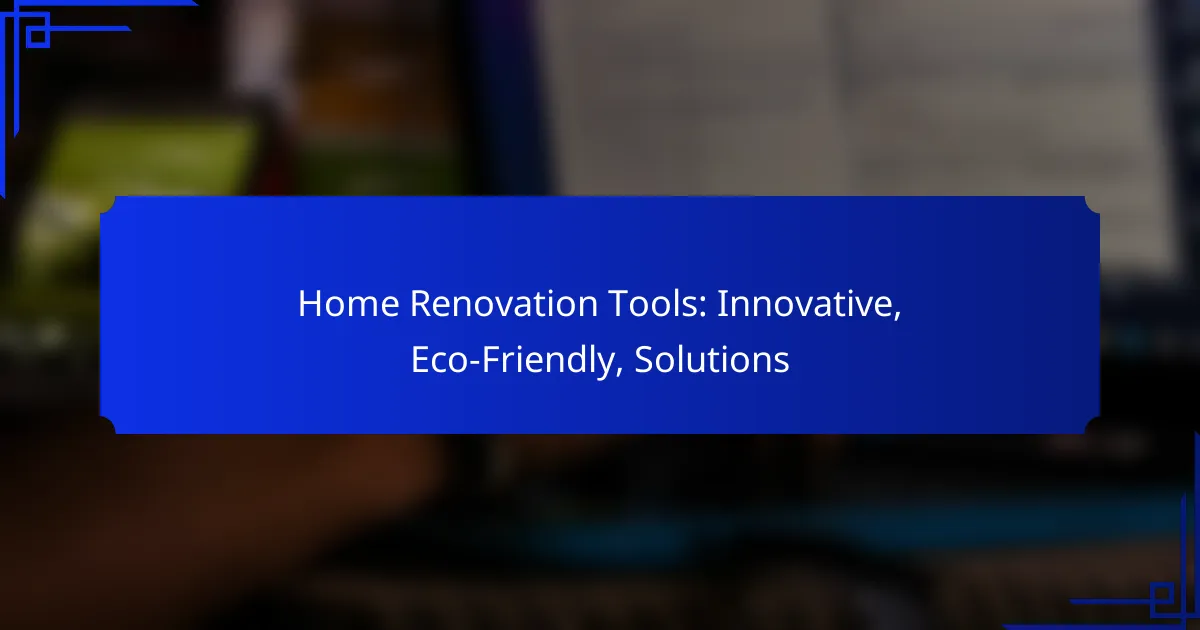In the realm of home renovation, eco-friendly tools are transforming the way we approach improvement projects by prioritizing sustainability and efficiency. These innovative solutions utilize renewable resources and recycled materials, ensuring that renovations are not only effective but also environmentally responsible. Brands like DeWalt, Makita, and Greenworks are at the forefront, providing high-performance tools that support greener practices without compromising on quality.

What are the best eco-friendly home renovation tools?
The best eco-friendly home renovation tools are designed to minimize environmental impact while maximizing efficiency. These tools often incorporate renewable energy sources, recycled materials, and sustainable practices to support greener home improvement projects.
Solar-powered tools
Solar-powered tools harness sunlight to operate, reducing reliance on electricity or batteries. Common examples include solar-powered saws, drills, and lights, which can be particularly useful for outdoor projects.
When selecting solar tools, consider their energy output and battery life. Look for models that offer efficient solar panels and quick charging times to ensure you can complete your tasks without interruption.
Recycled material tools
Tools made from recycled materials help reduce waste and promote sustainability. These can include items like hammers, screwdrivers, and measuring tapes crafted from repurposed plastics or metals.
Check for certifications or labels indicating the percentage of recycled content. Investing in these tools not only supports eco-friendly practices but often provides durable options that perform well.
Energy-efficient appliances
Energy-efficient appliances, such as low-energy refrigerators, washers, and dryers, consume less power while performing the same tasks. They are essential for any renovation that aims to reduce overall energy consumption.
Look for appliances with Energy Star ratings or similar certifications, which indicate compliance with energy efficiency standards. This can lead to significant savings on utility bills over time.
Low-VOC paint tools
Low-VOC (volatile organic compounds) paint tools are designed to minimize harmful emissions during home renovation. These tools include brushes, rollers, and sprayers that work well with low-VOC paints, ensuring a healthier indoor environment.
When choosing paint tools, ensure they are compatible with the specific low-VOC products you plan to use. This compatibility can enhance application quality and reduce the need for multiple coats.
Hand tools from sustainable sources
Hand tools sourced from sustainable materials, such as bamboo or responsibly harvested wood, offer eco-friendly alternatives to traditional metal tools. These tools are often biodegradable and have a lower carbon footprint in their production.
Research brands that prioritize sustainability in their manufacturing processes. Look for certifications that indicate ethical sourcing and environmental responsibility to ensure your tools align with eco-friendly values.

How can innovative tools enhance home renovation?
Innovative tools can significantly enhance home renovation by improving efficiency, accuracy, and sustainability. These advancements streamline processes, reduce waste, and offer customized solutions tailored to individual needs.
Smart home technology integration
Integrating smart home technology into renovations allows homeowners to automate and control various systems, such as lighting, heating, and security, from a single interface. This not only enhances convenience but also improves energy efficiency, potentially lowering utility bills.
Consider using smart thermostats, which can learn your schedule and adjust temperatures accordingly, or smart lighting systems that can be controlled remotely. These tools often come with user-friendly apps, making it easy to monitor and manage your home environment.
3D printing for custom solutions
3D printing offers a revolutionary approach to creating custom components for home renovations. This technology allows for the production of unique fixtures, fittings, and even furniture tailored to specific design preferences and spatial requirements.
For example, homeowners can print custom cabinet handles or decorative elements that fit perfectly with their interior design. The cost of 3D printing can vary, but it often proves more economical for one-off designs compared to traditional manufacturing methods.
Augmented reality for design planning
Augmented reality (AR) tools enable homeowners to visualize their renovation projects before any physical work begins. By overlaying digital designs onto real-world environments, AR helps in making informed decisions about layout, color schemes, and materials.
Using AR applications, you can see how new furniture or paint colors will look in your space, reducing the likelihood of costly mistakes. Many apps are available for smartphones and tablets, making this technology accessible and easy to use for planning renovations.

What are the top brands for eco-friendly renovation tools?
Several brands are leading the way in eco-friendly renovation tools, focusing on sustainability and innovative designs. Notable names include DeWalt, Makita, and Greenworks, each offering a range of tools that minimize environmental impact while maintaining high performance.
DeWalt’s sustainable line
DeWalt has developed a sustainable line of tools that emphasizes energy efficiency and reduced waste. Their products often feature brushless motors, which not only extend tool life but also enhance battery efficiency, leading to longer run times and less frequent charging.
When selecting DeWalt tools, consider their commitment to using recycled materials in manufacturing and packaging. This approach not only conserves resources but also aligns with eco-conscious renovation practices.
Makita’s eco-friendly tools
Makita offers a variety of eco-friendly tools designed with sustainability in mind. Their cordless tools utilize lithium-ion batteries, which are more efficient and have a lower environmental impact compared to traditional batteries. This technology allows for longer usage times and faster charging cycles.
Additionally, Makita focuses on reducing emissions in their manufacturing processes. Their tools are engineered for durability, which means fewer replacements and less waste over time, making them a smart choice for environmentally aware renovators.
Greenworks’ electric tools
Greenworks specializes in electric tools that are entirely battery-operated, eliminating the need for gas and reducing harmful emissions. Their product line includes lawn care equipment and power tools, all designed to provide high performance without the environmental drawbacks of fossil fuels.
Choosing Greenworks tools can significantly lower your carbon footprint during renovation projects. Their tools are often quieter and require less maintenance than gas-powered alternatives, making them ideal for residential areas and eco-friendly initiatives.

How to choose the right tools for your renovation project?
Selecting the right tools for your renovation project involves understanding your specific needs, evaluating the efficiency of available options, and being mindful of your budget. Prioritize tools that enhance productivity while aligning with eco-friendly practices to ensure a sustainable renovation process.
Assessing project requirements
Begin by clearly defining the scope of your renovation project. Identify the tasks you need to accomplish, such as demolition, framing, or finishing, as each will require different tools. For instance, a basic renovation may only need hand tools like hammers and screwdrivers, while larger projects might necessitate power tools like saws and drills.
Consider the materials you will be working with as well. Different materials, such as wood, drywall, or concrete, may require specialized tools for effective handling. Make a checklist of required tools based on your project’s specific demands to ensure you don’t overlook any essential items.
Evaluating tool efficiency
Efficiency in tools can significantly impact the timeline and quality of your renovation. Look for tools that offer features like ergonomic designs, battery efficiency, and multi-functionality. For example, a cordless drill with adjustable torque settings can save time and reduce fatigue compared to a standard drill.
Research user reviews and ratings to gauge the performance of tools you’re considering. Tools with higher ratings often indicate better reliability and effectiveness, which can lead to smoother project execution. Additionally, consider renting tools for one-time projects to avoid the cost of purchasing rarely used equipment.
Considering budget constraints
Your budget will play a crucial role in determining which tools to purchase or rent. Set a realistic budget that includes not only the cost of tools but also any necessary accessories or consumables. For example, if you plan to buy a power saw, factor in the cost of blades and safety gear.
Explore options for eco-friendly tools, which may have a higher upfront cost but can save money over time through energy efficiency and durability. Look for sales, discounts, or second-hand tools to stretch your budget further. Prioritize investing in high-quality tools that will last through multiple projects rather than opting for the cheapest available options.

What are the costs associated with eco-friendly renovation tools?
The costs of eco-friendly renovation tools can vary significantly based on the type of tool and its features. While the initial purchase price may be higher than traditional tools, many eco-friendly options offer long-term savings through durability and energy efficiency.
Initial investment vs. long-term savings
Eco-friendly renovation tools often require a higher initial investment due to their advanced materials and technology. However, these tools can lead to substantial long-term savings by reducing energy consumption and minimizing maintenance costs. For example, a high-efficiency power tool may cost more upfront but can save you money on electricity bills over time.
When considering the initial investment, think about the lifespan of the tool and how often you will use it. Tools designed for longevity can offset their higher price by providing years of reliable service.
Price ranges for popular brands
Researching different brands and comparing their offerings can help you find the best balance between cost and quality. Look for reviews and ratings to ensure you are investing in reliable tools.
Cost comparison of traditional vs. eco-friendly tools
When comparing traditional tools to eco-friendly options, consider both the upfront costs and the potential long-term expenses. Traditional tools may have lower initial prices, often ranging from $50 to $200, but they might incur higher operational costs due to energy consumption and maintenance.
Eco-friendly tools, while pricier initially, can lead to savings in energy bills and reduced environmental impact. For example, a traditional electric sander may cost less upfront but could use significantly more energy over its lifetime compared to a battery-operated, eco-friendly model.

What are the benefits of using innovative tools in home renovations?
Using innovative tools in home renovations enhances efficiency, reduces waste, and often leads to better quality results. These tools can streamline processes, making projects quicker and more environmentally friendly.
Increased Efficiency
Innovative tools are designed to simplify tasks, allowing homeowners and contractors to complete renovations faster. For instance, power tools with advanced features can cut down on manual labor, while smart technology can automate processes like lighting and temperature control.
Consider using tools like laser levels or digital measuring devices, which can save time and improve accuracy. These tools often reduce the need for rework, which can be costly and time-consuming.
Eco-Friendly Options
Many innovative tools are designed with sustainability in mind, helping to minimize environmental impact during renovations. Tools that utilize rechargeable batteries or are made from recycled materials contribute to a greener approach.
For example, electric saws that replace gas-powered models produce fewer emissions and noise, making them more suitable for residential areas. Additionally, tools that promote efficient material use can help reduce waste, aligning with eco-conscious renovation goals.
Cost Savings
Investing in innovative tools can lead to significant cost savings over time. While the initial purchase may be higher, the efficiency gained often results in lower labor costs and reduced material waste.
For instance, precision tools can help avoid costly mistakes, and energy-efficient tools can lower utility bills during the renovation process. Homeowners should weigh the upfront costs against potential long-term savings when selecting tools.
